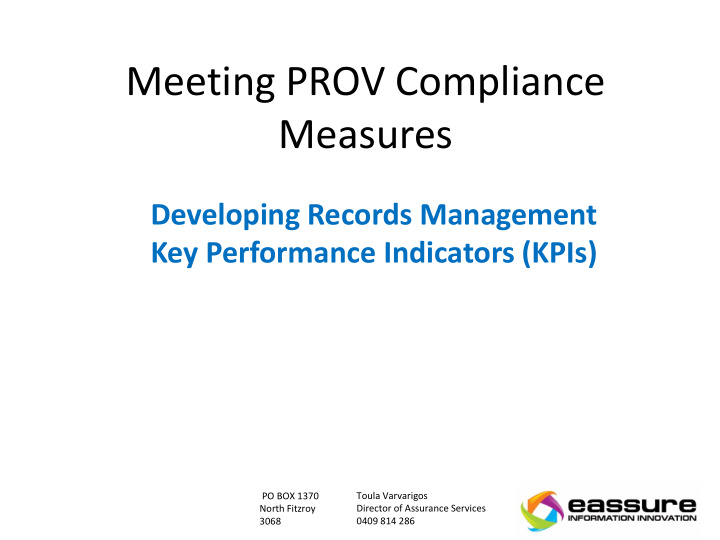



Meeting PROV Compliance Measures Developing Records Management Key Performance Indicators (KPIs) PO BOX 1370 Toula Varvarigos North Fitzroy Director of Assurance Services 3068 0409 814 286
Session Outline • What is the Compliance Measure? • What are KPIs? • KPI Characteristics • Why do we need KPIs? • Developing KPIs • Reporting on KPIs • Activity
What is the Compliance Measure? Records management performance measures are identified, integrated in the agency’s business and operational plans, and assessed for improvement each performance cycle. (Strategic Management PROS 10/10 S1, requirement 15.
What are Key Performance Indicators? Key Performance Indicators (KPIs) are quantitative and qualitative measures used to review an organisation's progress against its goals. These are broken down and set as targets for achievement by departments and individuals. The achievement of these targets is reviewed at regular intervals. (PROS 10/10 G3, p6.)
What are Key Performance Indicators? The following diagram illustrates the alignment of KPIs with an agency’s strategic direction (PROS 10/10 G3, p8) The records management strategy should contain high level, strategic KPIs for recordkeeping across the agency. The records management strategy should be in alignment with the strategic direction of the agency.
KPI Characteristics h) Used to identify trends a) Relevant and i) Timely Consistent j) Understood b) Focused on Agency k) Agreed wide strategic value l) Reported c) Representative m) Governed d) Realistic n) Resourced e) Specific o) Assessed f) Attainable p) May consist of direct or indirect indictors g) Measurable
Need for Key Performance Indicators • Decision making in terms of • Development of ‘benchmark’ risks and issues, as well as for for like business functions, broader planning purposes activities or services • Accreditation • • Use in individual staff Evidence for a business case • performance appraisals Raise the profile of records management • Continuous improvement • Development of Service Level initiatives Agreements (SLAs) • • Balanced scorecard programs KPIs become part of the review processes of the • Demonstrating and agency attributing business value • Evidential based improvement from services or changes to service delivery
Developing KPIs Method Description Statutory & Regulatory It may be appropriate to focus selection of KPIs on statutory and regulatory Requirements requirements and obligations. Lifecycle Approach KPIs may be developed using the record lifecycle. The use of a lifecycle approach to developing KPIs would ensure an agency takes into account KPIs at all stages of the life of a record, from creation to disposal. Risk Based The risk based approach identifies those specific services, functions or activities that may have a negative or detrimental impact on the agency. By identifying areas of risk, KPIs could be used to measure progress towards mitigating the risk. Cause & Effect A suggested approach is to examine specific areas of concern using the cause and effect technique. The approach analyses the cause(s) of ineffective or inefficient services, functions or activities and identifies KPIs that address the effect. By addressing the effect, improvements can generally be achieved. Strategic KPIs Strategic KPIs should address the measurements required at a high level and take a top down approach. For example, strategic KPIs should address records management governance and accountability. Operational KPIs Operational KPIs should be approached from the ground up. At this level, KPIs measure functions and activities of an operational nature, such as the delivery of records management services.
Developing KPIs • Ensure KPIs are realistic, measurable and achievable. • Narrowly focussed ‘day -to- day’ approaches should be avoided, fail to support overall business outcomes. • Group KPIs into categories based on the agency’s vision, strategy and objectives. (Optional) – Example Categories • Performance – services are relevant and appropriate to the organisation. • Reliability – service delivery is consistent, reliable, dependable and trustworthy. • Responsiveness and timeliness – responses to client requests and delivery of services are within timeframes and other measures. • Relationships – team members deliver services with tact, recognition, regard, and thoughtfulness. • Resources – time, budget and cost measures. • Secure – protect integrity and privacy of data.
Developing KPIs Example
Reporting on KPIs Example report – Strategic KPIs (PROS 10/10 G3, p31) Dashboard format reports can also be used for Strategic and Project KPI reporting.
Activity Develop a Suite of KPIs Group 1 - Operational Unit Managing Hardcopy Group 2 - Operational Unit Managing EDRMS Group 3 - Project EDRMS
Recommend
More recommend